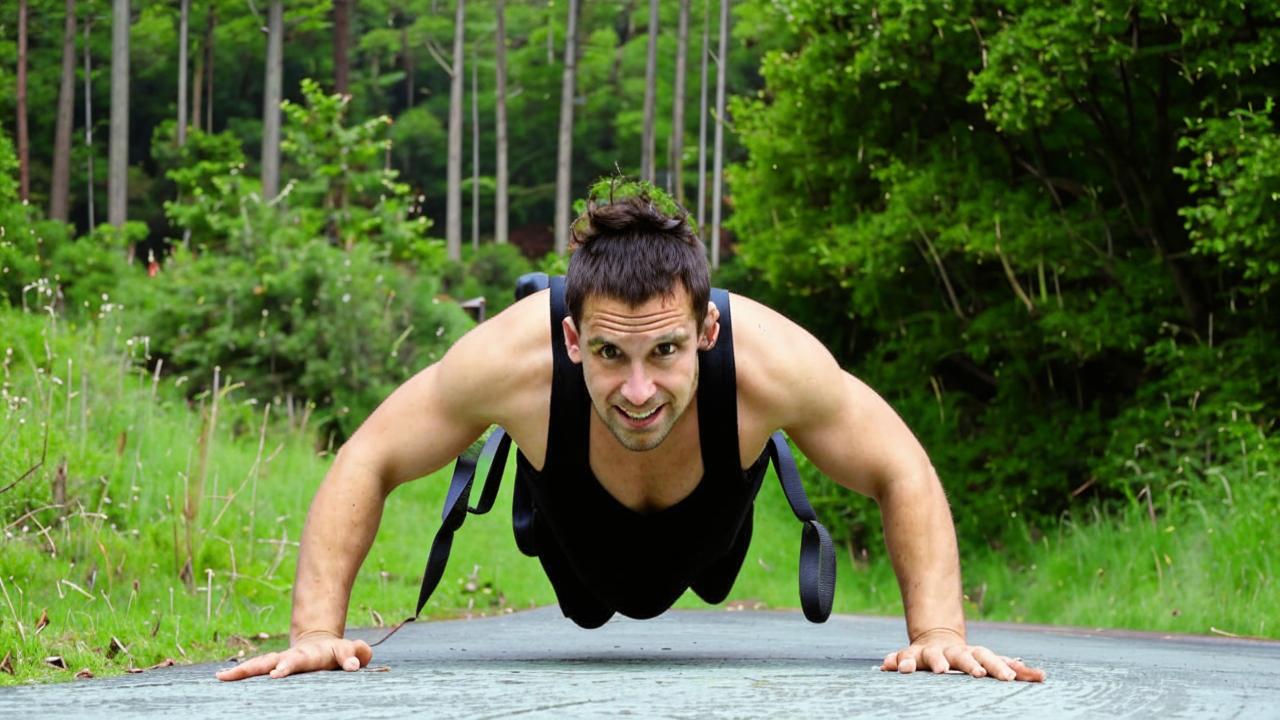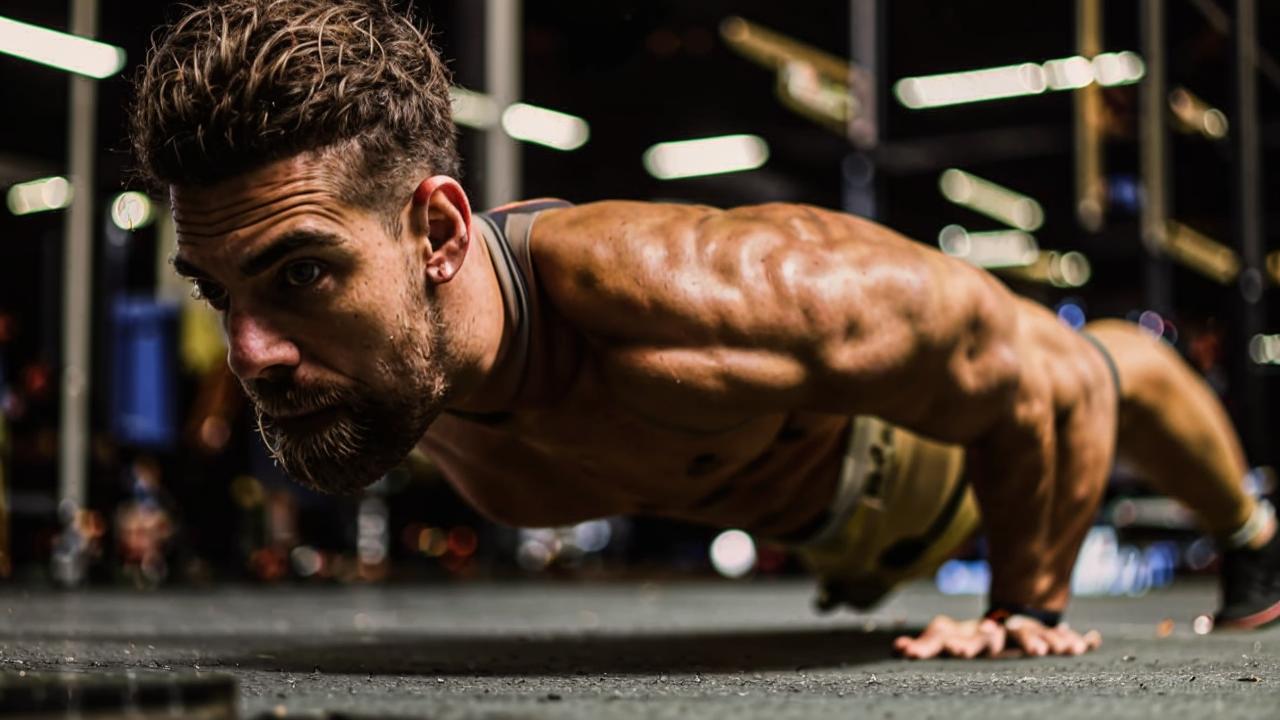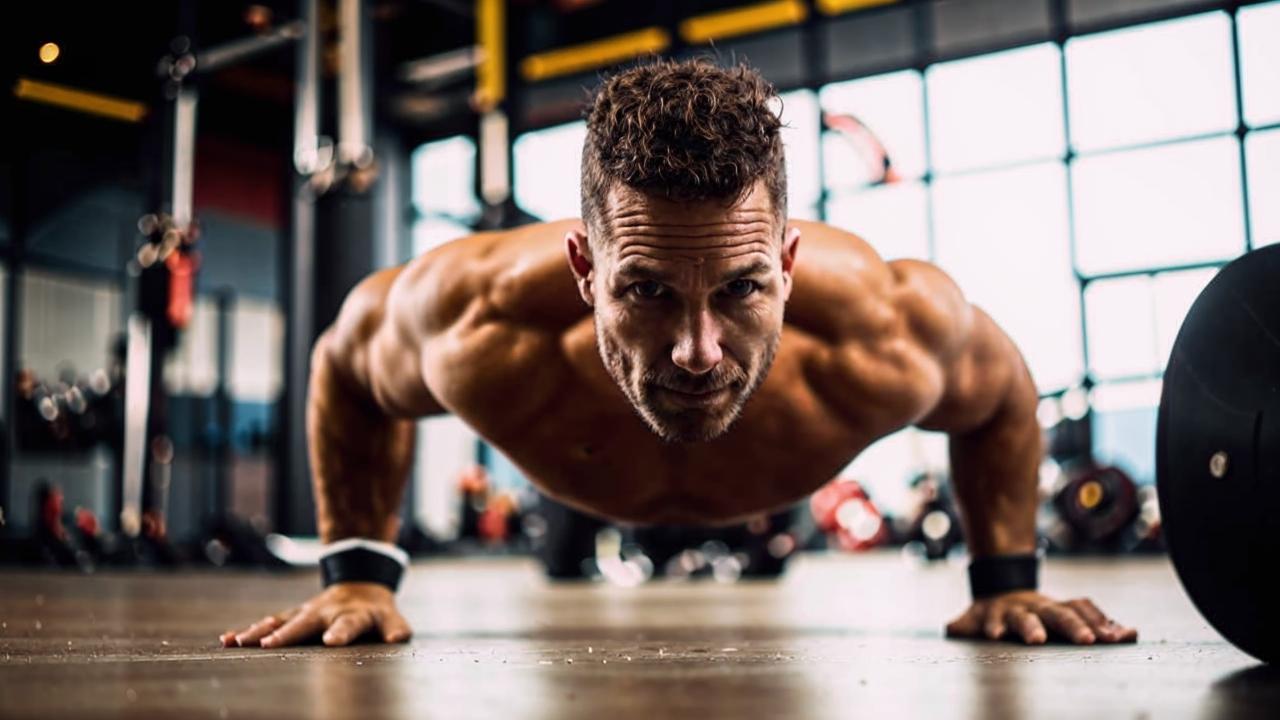
fitnes trener
“Push-ups with weights are an effective way to pump up the chest muscles, anterior deltoids and triceps in a home workout when you don’t have access to exercise equipment, barbells and dumbbells. Using additional weight in push-ups allows you to load the muscles more heavily, which helps to more effectively grow muscle mass and develop strength. They can be especially useful for those who have already reached a certain level of strength and need a new incentive to progress.”
According to research, people who can do more than 40 push-ups have a lower risk of having a heart attack, stroke and other cardiovascular problems compared to those who do less than 10 push-ups.
What muscles are being worked?
The push-up is a basic multi-joint exercise involving several muscle groups.
- The pectoral muscles get the bulk of the load during the exercise, pulling the upper arm toward the torso.
- The triceps muscle of the shoulder helps to extend the arms at the elbow when lifting the torso to the top point.
- The anterior bundle of the deltoid muscle flexes the shoulder during the exercise.
- The abs, including the rectus abdominis and obliques, stabilize the torso during the exercise.
- Forearm muscles allow you to hold and stabilize your arms in a static position during the exercise.
Ways to add additional weights
Each weight option has its own benefits and will be effective for its own purpose at a particular training phase.
Backpack with weights. You can load a backpack with books, water bottles, sandbags, or barbell disks. As a rule, when doing push-ups from the floor, the backpack is placed on the upper back in the area of the shoulder blades, and when doing push-ups on the bars, the backpack is placed in front of you or on your back.
Weighted Vest. The vest has built-in pockets for weights, allowing you to use weights from 5 to 25 kg or more, and the design of the vest distributes the load on the body evenly.
Weight belt. When doing push-ups on the bars, the belt is put on the hips and fastened to it with a chain with a weight. Such a belt allows you to use additional weight up to 150-200 kg.
Body position in space. If you don’t have any equipment, lift your legs on a chair or any other high surface so that they are higher than your torso. So you will shift the center of gravity and increase the load on the muscles.

Technique of push-ups with weights from the floor
- Put on a weighted backpack or weighted vest so that it is on your upper back closer to your shoulder blades.
- Stand with your arms straight and your body flat with your palms shoulder-width apart.
- The gaze is directed to the floor. Keep your neck straight, and keep your shoulder blades down and together. Make a slight bend in the lower back and tense the abs.
- Take a breath and lower your body to the floor, bending your arms at the elbow to a 90-degree angle. Pause briefly at the bottom point. Lower the body smoothly and without sudden movements.
- As you exhale, raise the body to the upper point, extending the arms in the elbow joints to a straight position.
Benefits of push-ups with weights
Pumping the muscles of the upper body. The exercise engages the muscles of the chest and arms, making them more massive and powerful. The use of additional weights allows you to constantly progress in results and gain muscle mass. Also, regular strength training helps to slow down age-related loss of muscle mass.
Health benefits. Regular workouts have a positive effect on physical and psychological health. Push-ups favorably affect the cardiovascular and respiratory systems of the body.
Joint health. Systematic performance of the exercise helps to improve the health of shoulder and elbow joints. If the upper body is weak, the stress on the joints and bones becomes greater and the risk of fracture or other injury increases. Also during exercise, joint mobility and metabolic processes in them improve.
Izboljšana športna zmogljivost. Push-ups with weights can be a useful addition to training in wrestling, boxing, grappling, MMA, powerlifting and other sports that require upper body strength.

Recommendations for training with push-ups with weights
Warm-up. Before training with additional weight, it is recommended to prepare ligaments, joints and tendons. Dedicate five minutes to shoulder rotator cuff exercises and then perform one or two warm-up push-ups with your own body weight. This will help you train harder and reduce the chance of injury.
Weight of the weights. For muscle pumping use 70-75% of the single-repetition maximum (1RM,) to increase strength – 80-95% of 1RM, for strength endurance train with weights – 55-65% of 1RM.
Number of repetitions and approaches. To develop strength it is optimal to do up to eight repetitions, to develop strength endurance – from 15, and for gaining muscle mass it is optimal from 8 to 12. According to research, it is recommended to build training so that a muscle group has 12 to 20 reps per week.
Rest time. If you are training strength rest between approaches – three to five minutes. If you are training for strength endurance, rest 20-60 seconds. When training to gain muscle mass, the optimal rest time is 60-90 seconds, for heavy basic exercises you can extend the rest to two to three minutes.
Increasing the load. Increase the weight of the weight, the number of repetitions and approaches gradually. Start with 8-10 reps in two to three approaches with the optimal weight. Then add one more repetition every or every other workout until you reach 15 repetitions in two to three sets. After that, increase the weight of the weights and repeat the cycle.
Dihanje. If you want to do a lot of reps with quality weight, you need to breathe evenly without holding your breath. Lack of oxygen negatively affects muscle performance and concentration. Inhale at the moment of lowering the torso, and exhale – at the peak effort when lifting the body up.
Hitrost izvajanja. Do the exercise at a measured pace, smoothly descending and powerfully rising up. Muscles can not count repetitions, it is important to them time under load, so it is better to do 10-15 quality repetitions than 15-20 in poor technique.

Kontraindikacije
Before strength training we recommend consulting a doctor to rule out possible contraindications, especially for people with diseases of the cardiovascular, endocrine and nervous systems, pregnancy, obesity, diabetes and joint diseases.
For the time being, limit the training of push-ups with weights in the following conditions:
- acute shoulder, elbow and wrist joint pain;
- acute pain in the cervical, thoracic and lumbar spine;
- high body temperature, infectious diseases and exacerbation of chronic diseases;
- recent injuries to the upper body during training.
Types of push-ups
Push-ups with legs raised to an elevated position
The technique of execution is similar to the classic push-ups from the floor, but the feet stand on an elevation. This option is suitable for those who do not have the opportunity to use any additional weights.
- Stand in a straight arm rest with a flat body position, placing the palms of your hands at shoulder width, and throw your feet on an elevated position to shift the weight of the body to the muscles of the upper part of the body.
- The gaze is directed toward the floor. Keep your neck straight, and keep your shoulder blades down and brought together. Avoid a strong bend in the lower back and tense the abs.
- Take a breath and lower your body to the floor, bending your arms at the elbow to a 90-degree angle. Pause briefly at the bottom point. Lower the body smoothly and without sudden movements.
- Exhale and raise the body to the upper point, extending the arms in the elbow joints to a straight position.

Push-ups with narrow arm positioning
With this technique, the hands are at less than shoulder width directly under the chest. The narrow arm placement is designed to work the chest and triceps muscles.
- Wear a weighted backpack or weighted vest so that it is on your upper back closer to your shoulder blades.
- Stand with your arms straight and your body flat, with your palms near your shoulders and your fingers pointing toward each other.
- The gaze is directed to the floor. Keep your neck straight, and keep your shoulder blades down and together. Make a slight bend in the lower back and tense the abs.
- Inhale and lower your body to the floor, bending your arms at the elbows to a right angle. Pause briefly at the bottom point. Lower the body smoothly and without sudden movements.
- Exhale and raise the body to the upper point, extending the arms in the elbow joints to a straight position.

Push-ups with a wide stance of the hands
With this technique, the hands stand wider than the shoulders. Wide arm placement is aimed at working the chest and deltoid muscles.
- Put on a weighted backpack or weighted vest so that it is on your upper back closer to your shoulder blades.
- Stand with your arms straight and your body flat with your palms shoulder-width apart, fingers pointing diagonally out to the sides.
- The gaze is directed to the floor. Keep your neck straight, and keep your shoulder blades down and together. Make a slight bend in the lower back and tense the abs.
- Inhale and lower your body to the floor, bending your arms at the elbows to a right angle. Pause briefly at the bottom point. Lower the body smoothly and without sudden movements.
- Exhale and raise the body to the upper point, extending the arms in the elbow joints.

Push-ups on the bars
Push-ups on the bars are more difficult than from the floor, so they are suitable for more experienced athletes.
- Wear a weight belt or weighted vest. Rest the palms of your straight arms on the uneven bars.
- Keep your eyes forward. Keep your neck straight, chest extended, shoulder blades down and together. Make a slight bend in the lower back and tense the abs.
- Take a breath and lower your torso down, bending your arms at the elbow to a 90-degree angle. Pause briefly at the bottom point. Lower yourself smoothly and without sudden movements.
- Exhale and raise the body to the upper point, extending the arms in the elbow joints to a straight position.
- Make sure that your arms do not overextend at the elbow when straightening. Also, do not reach down deeply to avoid shoulder injuries.

One-arm push-ups
An advanced version of push-ups that allows you to increase the load without using additional weights. Suitable for experienced lifters who do more than 40 push-ups with their own body weight.
- Stand in a one straight arm push-up with a straight body position, placing the palm of your hand under the center of your chest. It is important to get into a stable and comfortable position. Put your feet wide apart and put your other arm behind your back.
- The gaze is directed to the floor. Keep your neck straight, and keep your shoulder blades down and together. Make a slight bend in the lower back and tense the abs.
- Take a breath and lower the body to the floor, bending the arm in the elbow joint. Lower the body smoothly and without sudden movements.
- Exhale and raise the body to the upper point, extending the arm in the elbow joint to a straight position. Next perform the movement on the other arm.







